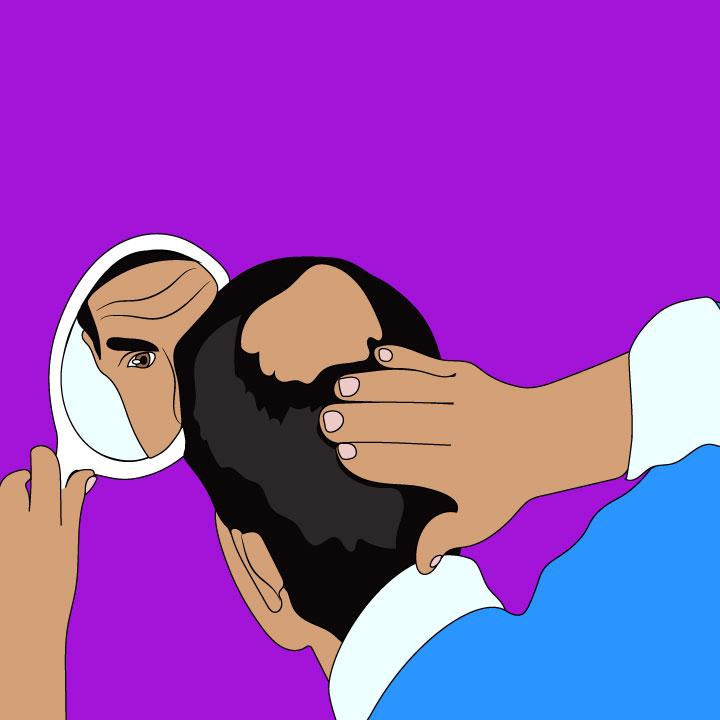The average person loses anywhere from 50 to 100 hairs a day—it’s part of the natural hair cycle and won’t make a difference on the scalp.
It only becomes a problem when there isn’t new hair to replace the ones that you’ve lost. A medical condition, it can be caused by a number of things from medications to hormonal changes.
Genetics can play a role as well. If anything, that’s what causes androgenic alopecia aka male pattern baldness.
Think you might have it? Want to know what some of the possible treatments are? If so, be sure to read the rest of the post!
What Is Male Pattern Baldness?
Male pattern baldness is a condition that causes loss of hair in men. In the United States, it affects nearly 50 million individuals. In fact, it’s said that more than half of all men will experience it to some extent by the age of 50.
And while it doesn’t pose any health threats, it can be psychologically distressing.
What Causes Male Pattern Baldness?
Male pattern baldness has to do with the male sex hormones aka androgens. More specifically, they have an effect on the hair growth cycle. Instead of producing new strands to replace the ones that have fallen out, the hair follicle shrinks.
Over time, this leads to baldness.
While the condition is often inherited, it can also be caused by other things such as medications and certain cancers. In cases like that, it’s often accompanied by a rash or peeling of the scalp.
Who’s At Risk?
When do men start balding? It depends, but male pattern baldness typically occurs when an individual is in his 30s or 40s (the likelihood increases with age). With that said, it can also happen during the teen years after puberty.
Since it’s genetic, those with a family history of the condition are also at a higher risk of developing the condition. This is especially true if it runs on the material side of the family.
Common Symptoms
Male pattern baldness shows up in a telltale shape. That is, it often starts as a receding hairline with thinning strands around the hair.
Over time, it’ll continue to move backward, forming an “M” shape. Eventually, as the hair becomes shorter and finer, it’ll create a horseshoe pattern with hair on the sides of the head.
Depending on the severity, the hairline may continue to recede until all of the strands are gone.
Treating Male Pattern Baldness
Unfortunately, there’s no cure for male pattern baldness. Having said that, there are treatments available for those who’d like to improve their appearance.
Medications
There are a couple of medications that can help with the condition, one of which includes a topical lotion or foam. Available over-the-counter, it works best on the crown of the head.
Keep in mind, however, that it can take several months for you to see results. Also, the medication must be used indefinitely to preserve the effects.
And while it’s typically well-tolerated, it can cause side effects such as itching, irritation, or swelling of the skin.
In addition to that, there’s a prescription medication that you can take orally. Put it simply, it prevents DHT, a male hormone, from shrinking the hair follicles on the scalp. In doing so, it can slow the progression of baldness.
As with the lotion, however, the effects will be reversed if the pill is stopped.
Wigs
Wigs can be used to cover receding hairlines, thinning hair, or complete baldness. The best part is that they come in a variety of colors and styles so that you can choose the one that’s right for you.
You can also work with a professional wig stylist for a more natural look.
Hair Weaves
Weaves are basically wigs that are sewn into your hair. There’s just one thing—you must have enough hair for them to work with.
Unlike wigs, which can easily come off, weaves will always stay on, even if you’re running or swimming. However, they must be sewn again whenever new hair growth occurs.
Hair Transplants
A hair transplant is the most invasive option and because of this, it’s often considered to be the last resort. How does it work?
A doctor will remove hair from areas of the scalp that still have active growth and transplant them to balding areas. Generally speaking, multiple treatments will be necessary.
Common side effects include numbness on the treated areas of the scalp, swelling, and scarring. The new hair may also appear less dense over time depending on the density of follicles in the transplanted area.
Is Male Pattern Baldness Preventable?
Currently, there’s no known way to prevent the condition. With that said, some researchers believe that it may help to reduce stress. Ultimately, this has to do with the fact that stress can contribute to hair loss by increasing sex hormones.
Given that, you may want to participate in relaxing activities such as walking or listening to soothing music.
Understanding Male Pattern Baldness
Now you know all about male pattern baldness. As you can see, it can be caused by various things from medications to genetics. Fortunately, there are ways to treat the condition. When in doubt, consult with your primary care doctor!
Did you enjoy this post? Looking for more pages like this? If so, why not check out the rest of our site?






